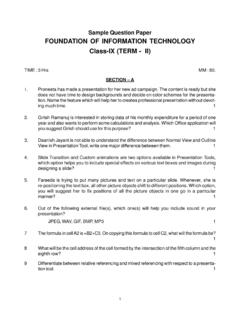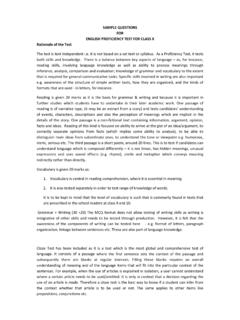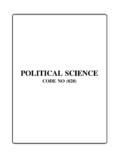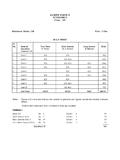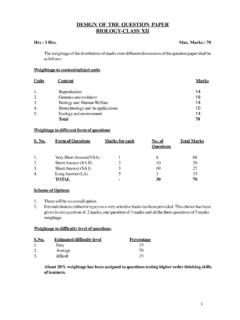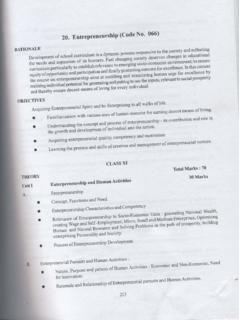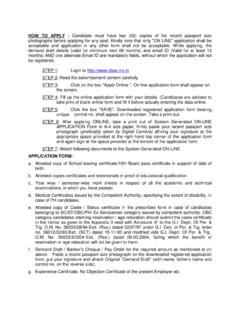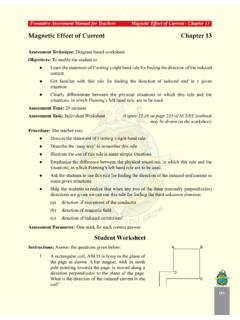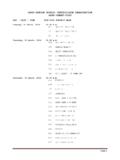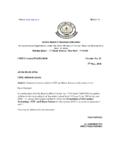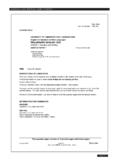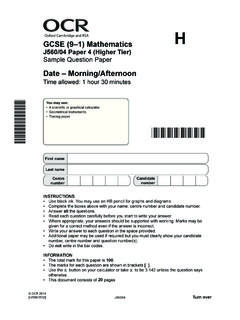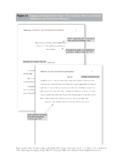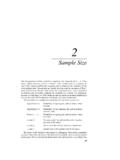Transcription of SAMPLE QUESTION PAPERS - CBSE
1 SAMPLE QUESTION PAPERSHISTORY, POLITICAL SCIENCE, GEOGRAPHY AND ECONOMICS inforCLASS XIICENTRAL BOARD OF SECONDARY EDUCATIONPREET VIHAR, DELHI - 110092(Effective for March, 2012 Examination)Revised Edition :DecemberCopies : Price : Rs. CBSE, 2010"This book or part thereof may not be reproduced by any person or agency in any manner" .PUBLISHED BY:The Secretary, Central Board of Secondary Education, Shiksha Kendra, 2, Community Centre, Preet Vihar, Delhi - 110092 DESIGN, LAYOUT &: Multi Graphics, 5745/81, Reghar Pura, Karol Bagh, New Delhi - BYPhone : 25783846 PRINTED BY :Hkkjr dk lafo/kum sf'kdkge] Hkkjr ds yksx] Hkkjr dks ,d ^ izHkqRo&laiUu lektoknh iaFkfujis{k yksdra=kkRed ; cukus ds fy,] rFkk mlds leLr ukxfjdksa dks%lkekftd] vkfFkZd vkSj jktuSfrd U;k;]fopkj] vfHkO.}
2 FDr] fo'okl] /eZvkSj mikluk dh Lora=krk]izfr"Bk vkSj volj dh lerk2izkIr djkus ds fy,] rFkk mu lc esa] O;fDr dh xfjek vkSj jk"V dh ,drk vkSj v[ lqfuf'pr djus okyh ca/qrk c<+kus ds fy, n`<+ladYi gksdj viuh bl lafo/ku lHkk esa vkt rkjh[k 26 uoEcj] 1949 bZ dks ,rn~}kjk bl lafo/ku dks vaxh r] vf/fu;fer vkSj vkRekfiZr djrs gSaA1-lafo/ku (c;kyhloka la'kks/u) vf/fu;e] 1976 dh /kjk 2 }kjk (3-1-1977) ls izHkqRo&laiUu yksdra=kkRed ; ds LFkku ij izfrLFkkfirA2-lafo/ku (c;kyhloka la'kks/u) vf/fu;e] 1976 dh /kjk 2 }kjk (3-1-1977 ls)] jk"V dh ,drk ds LFkku ij izfrLFkkfirAHkkx 4 dewy d kZO;51 d- ewy d kZO; & Hkkjr ds izR;sd ukxfjd dk ;g d kZO; gksxk fd og &(d) lafo/ku dk ikyu djs vkSj mlds vkn'kksZa] laLFkkvksa] jk"V ot vkSj jk"V xku dk vknj djs_([k)Lora=krk ds fy, gekjs jk"V h; vkanksyu dks izsfjr djus okys mPp vkn'kksZa dks n; esa latks, j[ks vkSj mudk ikyu djs_(x)Hkkjr dh izHkqrk] ,drk vkSj v[kaMrk dh j{kk djs vkSj mls v{ j[ks_(?)
3 K)ns'k dh j{kk djs vkSj vkg~oku fd, tkus ij jk"V dh lsok djs_( )Hkkjr ds lHkh yksxksa esa lejlrk vkSj leku Hkzkr`Ro dh Hkkouk dk djs tks /eZ] Hkk"kk vkSj izns'k ;k oxZ ij vk/kfjr lHkh HksnHkko ls ijs gksa] ,slh izFkkvksa dk R;kx djs tks fL=k;ksa ds lEeku ds fo# gSa_(p)gekjh lkekftd laL fr dh xkSjo'kkyh ijaijk dk eg o le>sa vkSj mldk ijh{ djsa_(N)izk frd i; dh ftlds varxZr ou] >hy] unh] vkSj oU; tho gSa] j{kk djs vkSj mldk lao/Zu djsa rFkk ds izfr n;kHkko j[ks_(t)oSKkfud n`f" ] ekuookn vkSj KkuktZu rFkk lq/kj dh Hkkouk dk fodkl djsa_(>)lkoZtfud laif k dks lqjf{kr j[ksa vkSj fgalk ls nwj jgsa_( k)O;fDrxr vkSj lkewfgd xfrfof/;ksa ds lHkh {ks=kksa esa mRd"kZ dh vksj c<+us dk lrr iz;kl djsa ftlls jk"V fujarj c<+rs gq, iz;Ru vkSj miyfC/ dh ubZ mapkb.}}}}}
4 Ksa dks Nw ysATHE CONSTITUTION OF INDIAPREAMBLE1WE, THE PEOPLE OF INDIA, having solemnly resolved to constitute India into a SOVEREIGN SOCIALIST SECULAR DEMOCRATIC REPUBLIC and to secure to all its citizens :JUSTICE, social, economic and political;LIBERTY of thought, expression, belief, faith and worship;EQUALITY of status and of opportunity; and to promote among them all 2 FRATERNITY assuring the dignity of the individual and the [unity and integrity of the Nation]; IN OUR CONSTITUENT ASSEMBLY this twenty-sixth day of November, 1949, do HEREBY ADOPT, ENACT AND GIVE TO OURSELVES THIS CONSTITUTION OF INDIAC hapter IV AFundamental DutiesARTICLE 51 AFundamental Duties - It shall be the duty of every citizen of India-(a)to abide by the Constitution and respect its ideals and institutions, the National Flag and the National Anthem;(b)to cherish and follow the noble ideals which inspired our national struggle for freedom;(c)to uphold and protect the sovereignty, unity and integrity of India.
5 (d)to defend the country and render national service when called upon to do so;(e)To promote harmony and the spirit of common brotherhood amongst all the people of India transcending religious, linguistic and regional or sectional diversities; to renounce practices derogatory to the dignity of women;(f)to value and preserve the rich heritage of our composite culture;(g)to protect and improve the natural environment including forests, lakes, rivers, wild life and to have compassion for living creatures;(h)to develop the scientific temper, humanism and the spirit of inquiry and reform;(i)to safeguard public property and to abjure violence;(j)to strive towards excellence in all spheres of individual and collective activity so that the nation constantly rises to higher levels of endeavour and by the Constitution (Forty-Second Amendment) Act.
6 1976, sec. 2, for "Sovereign Democratic Republic ( ) by the Constitution (Forty-Second Amendment) Act. 1976, sec. 2, for "unity of the Nation ( )Senior Secondary stage is a crucial and challenging stage of school education as it is a transition from general foundation learning to discipline based education. Based on the National Curriculum Framework, 2005, new syllabi have been prescribed and textbooks have been brought out by NCERT. This has led to a paradigm shift in not only the pedagogy but also in examination pattern. Changes in the design of QUESTION PAPERS for Board Examination 2008 and onwards have already been posted on our website based on which SAMPLE QUESTION PAPERS have been developed in Business Studies, Economics, Accountancy and Mathematics.
7 Marking Schemes to the SAMPLE PAPERS give clear and concise instructions on solutions and evaluation criteria. The highlights of the changes effected in the QUESTION paper design are as follows:- Introduction of about 10% very short answer questions of one mark each. Replacement of memory based recall type of questions by thought provoking questions. Earmarking 20% of the questions in the QUESTION paper to assess higher order mental skills of learners, such as analysis, evaluation and interpretation of concepts and their application to real life situations for enhanced understanding, problem solving and enriched is hoped that these SAMPLE QUESTION PAPERS will guide the teachers in developing their own QUESTION PAPERS which will help students in facing examinations as festivals.
8 This will also lead to development of Higher Order Thinking skills in students. I express my heartfelt appreciation for the sincere efforts put in by the experts in all subject committees. Thanks are due to Mr. N. Nagaraju, Director (Academic) and Ms. Sugandh Sharma, Education Officer (Commerce) in providing necessary guidance to the experts and coordinating all activities in bringing out this document. Improvement is a continuous process and CBSE always looks forward to suggestions for further improvement in the JOSHI, , QUESTION PAPERS IN HISTORY1-28 Design of QUESTION Papers2 SAMPLE QUESTION QUESTION PAPERS IN POLITICAL SCIENCE29-70 Design of QUESTION Papers30 SAMPLE QUESTION paper -I33 SAMPLE QUESTION QUESTION PAPERS IN GEOGRAPHY71-116 Design of QUESTION Papers72 SAMPLE QUESTION paper -I79 SAMPLE QUESTION QUESTION PAPERS IN ECONOMICS117-159 Design of QUESTION Papers118 SAMPLE QUESTION paper -I121 SAMPLE QUESTION paper -II141 CONTENTSHISTORYCODE NO (027)1 DESIGN OF QUESTION PAPERHISTORYCLASS XIITIME : 3 hours Max.
9 Marks : 100I. Weightage to form of questionsForm of QUESTION No. of Marks for Total marksquestions each questionLong answer (LA) 2 10 20 Short answer (SA) 8 5 40 Very short answers 3 2 6 Passage based questions* 3 824 Skill (Map work) 2 5 10 Total 18 100 Note : Each Passage based QUESTION will have 3-4 questions with marks ranging from 1 to Weightage to contentThemes in Indian History (Part 1)25 marksThemes in Indian History (Part 2) 30 marksThemes in Indian History (Part 3) 35 marksMap work 10 marksIII. Weightage to Difficulty LevelEssential difficulty level PercentageA Easy 30%B Average 50%C Difficult 20%2IV.
10 Division of QUESTION PaperThe QUESTION paper will be divided into A, B, C, D and E. Part A will carry 3 questions of 2 marks each. Part B will carry 8 questions of 5 marks each. Part C will carry 2 questions of 10 marks each. Part D will carry three passage-based questions. The number of questions will vary from 3to 4. The marks will range from 1 to 4. The sources will be taken from the textbooks as directed therein. Part E will have 2 maps questions of 5 marks Scheme of OptionPart A will have no choicePart B will be divided into 3 sections (books).
